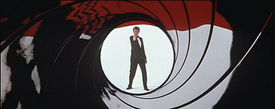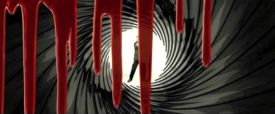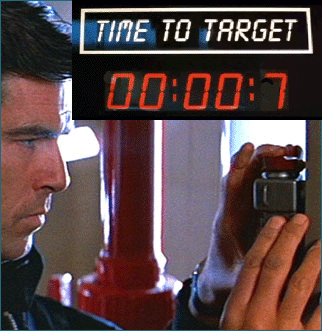The first man to portray James Bond in the gun barrel sequence was not Sean Connery, but rather Bob Simmons, Connery's stunt double. He is the shooting spy in the gun barrel sequence that is the introductory image for the first three films (Dr. No, From Russia with Love, and Goldfinger) — hence the hat, a time-honoured stuntman's technique for obscuring facial features.
The first appearance of Sean Connery in the sequence was in Thunderball. For this movie, the producers switched the film type from British Standard to Panavision, so the sequence had to be reshot. From that point forward, the actor who played Bond in the film was used in the sequence.[1]
During the opening of Dr. No, the white dot stops mid-screen and the credit line "Harry Saltzman & Albert R. Broccoli Present" appears across the dot. The text is wiped and the dot continues the sequence. The electronic prelude is interrupted by the gunshot, then the "James Bond Theme" plays very loudly, albeit the first notes are truncated. Instead of a single dot immediately introducing the opening scene, series of dot patterns randomly appear and disappear as the opening credits are presented.
The first time the full "James Bond Theme" was used with the gun barrel sequence was in From Russia with Love. Moreover, Dr. No is the only film featuring the circular, shooting agent motif in the beginning and the end (as an iconic still image).
In the Sean Connery gun barrel (Thunderball, You Only Live Twice, and Diamonds Are Forever), Bond wobbles slightly while firing his gun as he adjusts his balance from an unstable position and he bends over to fire.
From Dr. No to Diamonds Are Forever, the gun barrel sequences by Bob Simmons, Sean Connery, and George Lazenby featured James Bond in a business suit and trilby.
In Dr. No, before Monty Norman's "James Bond Theme", as the white circles traverse the screen, an electronic beeping is heard which anticipates the sounds in the film's nuclear-HQ climax. This sound is heard in the "Kiss of Life" track in Die Another Day in homage to the original film.
The main action of the first three films opens with the dot, white once more, simply disappearing — in the cases of From Russia with Love and Goldfinger, it becomes smaller while jumping to the corner of the frame before disappearing. For all subsequent films, the opening scene appears in the circle, stopped centre-screen. With the exception of For Your Eyes Only (1981), where the frame suddenly disappears to a musical cue, the circle then expands until the scene it contains fills the screen.
George Lazenby
George Lazenby, in On Her Majesty's Secret Service (1969), is the only James Bond who kneels down to fire. Also, this is the only film where the descending blood erases Bond's image (the Casino Royale gunbarrel seems to erase Bond, but upon a closer look, only darkens the image and Bond can still be seen under the red).
In Lazenby's gun barrel sequence, when the circle opens, James Bond is walking, but the barrel is still. When the barrel stops centre-screen, Bond is still walking to position for a half second before turning and shooting. This version is the only one which has the resulting treadmill effect. Note how after the gunbarrel fades, only the leftover circle wobbles - as opposed to all the other gunbarrels, wherein we see the entire gunbarrel wobble after Bond fires his gun, then leaving the leftover circle.
In On Her Majesty's Secret Service, the gun barrel sequence by George Lazenby featured James Bond in business suit and hat.
During the opening of On Her Majesty's Secret Service, the white dot stops mid-screen and the credit line "Harry Saltzman and Albert R. Broccoli present" appears across the dot. The text is wiped and the dot continues the sequence. The James Bond theme keeps playing.
Roger Moore
When Roger Moore assumed the role in Live and Let Die (1973), James Bond does not wear a trilby, but continues wearing a business suit. Later films, beginning with The Spy Who Loved Me (1977) feature Bond in black tie, wearing a tuxedo, as did Timothy Dalton and Pierce Brosnan.
Roger Moore was the only actor to film the sequence twice. Roger Moore's first two films in the series reverted to a lesser widescreen format of 1:85:1 for theatrical release. Panavision photography was reinstated for The Spy Who Loved Me, necessitating a fifth version of the gun barrel sequence. Roger Moore's James Bond uses both hands to fire his gun, his left hand bracing his gun arm.
] Timothy Dalton
In The Living Daylights (1987), Timothy Dalton fires with only one hand, and leans towards the right of the screen. This was reused in Licence to Kill (1989).
Pierce Brosnan

Beginning with GoldenEye (1995), the gun barrel was computer-generated, emphasising light and shade variations in the rifling spiral as the reflected light shifts with the barrel's movement. Die Another Day (2002), featured a CG bullet zooming (with a distinctively different firing sound) from Bond's gun towards the viewer and disappearing — suggesting he has shot straight in to his opponent's gun, possibly causing it to misfire and kill his opponent (the bullet appears to be from the GoldenEye credits). This sequence is a single, commemorative effect celebrating the release of the 20th James Bond film and the 40th anniversary of the film series.[citation needed] The blood is more realistic in this version.
Daniel Craig

The gun barrel sequence was revised again for Daniel Craig's first portrayal of Agent 007 in Casino Royale, released late in 2006. Unlike in previous films of the series, the gun barrel sequence does not open the film, but instead is incorporated to the ending of the pre-title sequence: Bond's first "kill" recovers and seizes his pistol to shoot Bond in the back. As the man brings his pistol up, the frame shifts instantly to the gun barrel. Bond spins around and shoots the man.
This sequence is noticeably different from the Pierce Brosnan-era computer-generated iteration: it has 28 shiny riflings and faster falling, 3D blood and leads directly to the opening titles. It is the first gun barrel sequence without some variation of the "James Bond Theme" and also the only rendition beginning with Bond stationary and his back to the camera. Daniel Craig's James Bond is the first shown wearing an open-necked shirt instead of a business suit or a tuxedo. Because of the tiles on the bathroom wall, Bond is not shown against a plain white background. This is also the only instance in the series where the audience has seen the person whom Bond shoots. Given the context of this gunbarrel sequence, it has been suggested (though not confirmed) that a more traditional gunbarrel sequence will be used in Craig's second appearance as Bond in Bond 22.
This is the first gunbarrel to happen at the end of the pre-titles sequence and the first since Dr. No to lead directly into the title sequence.
In the teaser trailer for Casino Royale, the gun barrel sequence uses the previous elements of the Brosnan-era but features the new Bond, Daniel Craig.
Music
While the sequence has traditionally featured the "James Bond Theme" (with the exception of Daniel Craig's gun barrel sequence in Casino Royale, which instead led to the film's title song by Chris Cornell), some composers have not used the dramatic opening bars that punctuate the appearance of the white dots. Others, while retaining them, have felt free to noticeably alter the usual rendition, e.g. Michael Kamen and Éric Serra, who scored Licence to Kill and GoldenEye respectively. Kamen's orchestration was a symphonic fanfare, while Serra's arrangement is of electronic motifs.
Other uses
The gun barrel sequence is copyrighted to EON Productions and is widely used in advertisements and merchandise. References to its circular motif regularly appear in the films' trailers, where the view moves down, into the gun barrel and 007 turns and shoots. The first third of the opening credits to Dr. No are based upon the circular motif, as well. GoldenEye's trailer replicates the sequence, wherein James Bond walks out and fires at the words "(But You Can Still Depend) on One Man" until it reads as the number "007", (leaving two Os and a 7 from the M). It was used in the release of the video game Agent Under Fire in a commercial asking, "Do you have what it takes to be Bond?", and showing people trying to repeat the shot, but spoiling the try. This is similar to the Japanese commercial for the release of GoldenEye 007 for the Nintendo 64 — the game uses the gun barrel sequence in the opening titles. Casino Royale's trailer also depict the gun barrel sequence. Also, a Wal-Mart exclusive commercial for The World Is Not Enough (the old scan system was around, where you scanned a game and a short trailer would play) parodied the gun-barrel by replacing Bond with a man that looked remarkably like Zukovsky; he was shot at with a machine-gun before diving off-screen.
In the video games Nightfire, Everything or Nothing, and From Russia with Love, the same sequence as the movies was used at the very start of the game. After the first mission of Everything or Nothing, it is used again in the title sequence, except it does not feature the white circular dots, but Bond just walking up to the gun and firing it directly at the camera. From Russia with Love uses the Bob Simmons gun barrel from the film of same name.
Parodies
As with any cultural icon, the gunbarrel sequence has inspired numerous parodies and takeoffs since its first appearance in 1962. A few examples:
- It was an opening couch gag in the episode "And Maggie Makes Three" of The Simpsons wherein Homer Simpson performs the gun barrel sequence in his living room.
- Famously, it is the parody opening of Friday the 13th Part VI: Jason Lives.
- The film From Hong Kong with Love (released as Bons baisers de Hong Kong in 1975) is about the British SIS replacing James Bond, who was killed in the gun barrel sequence; notably the film features Bernard Lee and Lois Maxwell, who were M and Miss Moneypenny in the official series.
- The title sequence of The Nude Bomb, the first feature-length movie version of the Get Smart TV series, which was itself a spoof of the Bond genre, features Don Adams as agent Maxwell Smart aiming a gun in a profusion of circles and ultimately becoming confused by his many simultaneous appearances.
- It is parodied in the Monty Python's Flying Circus episode, "Blood, Devastation, Death, War and Horror" with a pantomime horse; that is followed by a high-speed chase with horses as secret agents.
- Another use is at the start of the 12th episode of the web series Pure Pwnage.
- In 1987, the American television programme Saturday Night Live parodied the gun barrel sequence and everything James Bond in the sketch "Bullets Aren't Cheap" a.k.a. "Tightwad 007", featuring Steve Martin (as Bond) and Sting (as Goldsting); it is on the Best of Steve Martin DVD.
- It was also somewhat parodied in an episode of CSI where the victim is seen through the killer's gun barrel, but unlike Bond, the victim does not turn around to shoot first, but gets shot himself, as a bullet suddenly appears from the gun barrel the camera is looking through.
- In the Australian series Fast Forward, a Bond parody has 007 in the gun barrel sequence. When he turns to fire, the gun shoots him dead instead. Soon a film crew member appears and says, "All right, who's the smartarse who put real bullets in the gun?"
- When Australia's Channel Ten played the classic Bond films sponsored by Nissan, a promotion featured a man acting as Bond walking across the screen in the gun barrel, then getting into a Nissan which hastily drives off, before the blood falls and the Nissan logo is revealed.
- The sequence is parodied again in an episode of Robot Chicken with a Jewish Bond. The sequence opens normally, but the gun barrel is in the shape of the Star of David. Bond walks by normally and shoots at the gun barrel and as blood runs down the screen, Bond says, "Ah, don't get any blood on the new carpet."
- The sequence is parodied in Spongebob Squarepants in the episode "Spy Buddies", with a gunbarrel and Spongebob walking to reveal his spatula, then Patrick saying, "Hey, Spongebob, I can see you through my straw."
- The sequence is spoofed in promos for The Bill Thompson Show's new set, with Thompson firing the gun with both hands.
References
- ^ A Guide to the James Bond Teasers Ian Fleming.org













